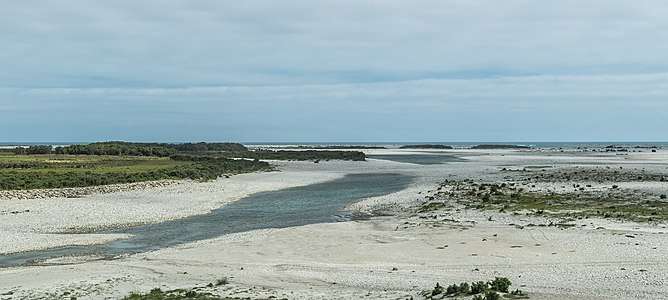Attrition (erosion)
In environmental science, attrition is a form of coastal or river erosion, when the bed load is eroded by itself and the bed. As rocks are transported downstream along a riverbed, the regular impacts between the grains themselves and between the grains and the bed cause them to be broken into smaller fragments. This process also makes them rounder and smoother. Attrition can also occur in glaciated regions, where it is caused by the movement of ice with embedded boulders over surface sediments. Similar effects on particulate material can be observed in chemical and mechanical manufacturing environments.
Mechanism
- Effects of attrition along the Haast River in New Zealand
 Pebbles tend to be larger upstream...
Pebbles tend to be larger upstream... ...and decrease farther downstream...
...and decrease farther downstream...
The amount of attrition is dependent on a number of factors: particle properties such as size, shape, surface, porosity, hardness, and cracks, and environmental properties such as time, velocity, pressure, shear, and temperature.[1]
Generally, particles are more affected by attrition farther upstream, as the rivers' velocity tends to be higher, and therefore its competence (ability to carry sediment) is increased. This means that the load rubs against itself more and with more force when suspended in the river, thus increasing erosion by attrition, though there is a point after transport over a certain distance that pebbles reach a size that is relatively immune to further attrition. Grain-size distribution of sediments produced by attrition will also be controlled by the lithology of the rock from which they are derived. Particle sizes generally decrease continuously as the river flows farther downstream, in a process called downstream fining.[2]
Similar processes
The effects of attrition can be mistaken for the effects of sorting, in which the grain size of sediments is affected by sediment transport mechanisms e.g. suspension vs. bed load. This affects pebble beaches the most as the pebbles smash into each other, which causes them to smooth.[3]
Attrition of particulate material is also observed in the chemical industry, where it is undesirable. Products can be lost through the process and contaminants can be created, requiring additional filtration. Attrition occurring in an industrial application stems from a wide range of mechanisms: mechanical, thermal, and chemical.[1]
In abrasive blasting, the useful life of the abrasive (sand or shot) is limited by attrition because as the workpiece surface is worn down, the abrasive breaks down as well.[1]
See also
References
- Bemrose, C.R.; Bridgwater, J. (January 1987). "A review of attrition and attrition test methods". Powder Technology. 49 (2): 97–126. doi:10.1016/0032-5910(87)80054-2. ISSN 0032-5910.
- Gomez, Basil; Rosser, Brenda J.; Peacock, David H.; Hicks, D. Murray; Palmer, Julie A. (June 2001). "Downstream fining in a rapidly aggrading gravel bed river". Water Resources Research. 37 (6): 1813–1823. Bibcode:2001WRR....37.1813G. doi:10.1029/2001wr900007. ISSN 0043-1397.
- Miller, Kimberly Litwin; Szabó, Tímea; Jerolmack, Douglas J.; Domokos, Gábor (November 2014). "Quantifying the significance of abrasion and selective transport for downstream fluvial grain size evolution". Journal of Geophysical Research: Earth Surface. 119 (11): 2412–2429. Bibcode:2014JGRF..119.2412M. doi:10.1002/2014jf003156. ISSN 2169-9003.